Spanish Republican Air Force facts for kids
Quick facts for kids Spanish Republican Air Force |
|
|---|---|
| Fuerzas Aéreas de la República Española (FARE) | |
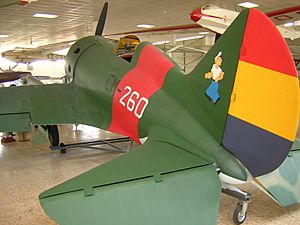
Popeye on the Spanish Republican Polikarpov I-16 of Antonio Arias Arias, commander of the 4th squadron. Museo del Aire, Cuatro Vientos, Madrid. Other characters on Spanish Republican planes included Mickey Mouse and Betty Boop.
|
|
| Active | 1931–1939 |
| Country | |
| Allegiance | Spain (1931–1939) |
| Branch | Spanish Republican Armed Forces |
| Type | Air Force |
| Engagements | Spanish Civil War |
| Commanders | |
| Notable commanders |
|
| Insignia | |
| Emblem | |
| Fin flash |  |
| Roundel (1931–1936) |
 |
| Roundel (1936–1939) |
 |
| Aircraft flown | |
| Attack | Breguet XIX, Vickers Vildebeest, Beechcraft Staggerwing, Gourdou-Leseurre GL-633, Potez 25 |
| Bomber | Potez 540, Tupolev SB, Bloch MB.200, Bloch MB.210, Polikarpov R-Z, Hawker Spanish Osprey, Macchi M.18, Breguet 413, Breguet 460 |
| Fighter | Hawker Fury, Bristol Bulldog, Blériot-SPAD S.51, Blériot-SPAD S.91, Dewoitine D.510, Fokker D.XXI, Martinsyde Buzzard, Hispano-Nieuport Ni-52, Avia BH-33, Dewoitine D.372, Polikarpov I-15, Polikarpov I-16, Grumman G-23, Letov Š-31, Letov Š-231, Letov Š-331, Loire 46, Fw 56 |
| Patrol | Latecoere 28, Spartan Zeus, Lockheed Orion, Fokker C.X, Miles Falcon, RWD 9, Macchi M.18, Potez 58 |
| Reconnaissance | Polikarpov R-5, Bellanca CH-300, Savoia-Marchetti SM.62, Aero A.101, Koolhoven F.K.51 |
| Trainer | Monospar ST-4, Monospar ST-12, Avro 594, Avro 626, Avro 643 Cadet, British Aircraft Swallow, Caudron C.270, Caudron C.282, González Gil-Pazó GP-1, Hanriot H.180, Hispano-Suiza E-30, Hispano-Suiza E-34, Miles M.2 Hawk Trainer, Morane-Saulnier MS.181, Morane-Saulnier MS.230, Romano R.82, Romano R.83, SAB-SEMA 10, RSV.32 |
| Transport | Fokker F-VII.3m/M, Fokker F.XX, De Havilland DH-89M, Farman F 402, Douglas DC-1, Douglas DC-2, Junkers K 30, Airspeed Envoy, Airspeed Viceroy, Avia 51, Blériot 111, Blériot-SPAD S.56, Breguet 26T, Breguet 470, British Aircraft Eagle, Caudron C-440, Caudron C.600 Aiglon, Consolidated Fleetster, Couzinet 101, Ford Trimotor, General Aircraft ST-25, Hanriot LH.437, Latécoère 28, Lioré et Olivier 213, Northrop Delta, Northrop Gamma, Potez 560, Vultee V-1 See also List of aircraft of the Spanish Republican Air Force |
The Spanish Republican Air Force was the air branch of the Armed Forces of the Second Spanish Republic. This was the official government of Spain from 1931 to 1939.
At first, it had two parts: the Military Aeronautics (Aeronáutica Militar) and Naval Aeronautics (Aeronáutica Naval). In September 1936, during the Spanish Civil War, these parts joined. They became the Air Forces of the Spanish Republic (Fuerzas Aéreas de la República Española (FARE)). People also called it Arma de Aviación.
This air force is famous for its role in the Civil War, which lasted from July 1936 to 1939. It was often called "La Gloriosa" (The Glorious One). However, some historians say its leaders struggled to make quick decisions during the war.
For example, in July 1936, the rebel side moved many troops from Spanish Morocco by air. They used slow Ju 52 planes. The Republican Air Force could not stop this. This was the world's first long-distance combat airlift.
The Republican Air Force fought well in the Battle of Guadalajara. They also defended the skies over Madrid during its long siege. But in other big battles, like the Battle of Teruel, their planes were often missing. When they did appear, their attacks were not well organized. Most Republican planes that survived the war were later used by the winning side.
Contents
History of the Air Force
The Spanish Republican Air Force had two main periods. The first was before the Civil War began in July 1936. The second was during the war. At this time, the air force was reorganized to meet the urgent needs of the government.
Early Years of the Air Force
When the Spanish Republic began in 1931, the Spanish Air Force had mostly French planes. Some of these were left over from the Rif War (1920–1926). General Luis Lombarte Serrano became the new chief-commander. Later, Commander Ramón Franco took over. He was a national hero who had flown across the Atlantic Ocean.
Aviation was growing in Spain. In 1931, Captain Cipriano Rodríguez Díaz and Lieutenant Carlos de Haya González flew non-stop to Equatorial Guinea. This was a Spanish colony at the time. In 1933, Captain Warlela used modern aerial photography to map Spain. The next year, engineer Juan de la Cierva landed his autogyro on the seaplane carrier Dédalo.
In 1934, Commander Eduardo Sáenz de Buruaga became the new chief. The air force was also reorganized that year. By 1936, the air force units were set up into Military Regions. This system is still used today in the Spanish Air Force.
Five years after the Republic started, a part of the army in Spanish Morocco rebelled. This was led by General Francisco Franco. This rebellion split Spain and started the bloody Spanish Civil War. During the war, the Republican Air Force had to fight against the better-equipped Aviación Nacional. This was the air force of the rebels, helped by Italian Fascist and Third Reich supporters.
The Spanish Civil War
After the rebellion on July 18, 1936, the Republican government lost some planes. These were at airfields controlled by the rebels. But the loyal areas of Spain still had most of the 60 Breguet XIX, 27 Vickers Vildebeest, and 56 Hispano-Nieuport Ni-52 planes.
To fight the war, the Republican government bought planes from France in July 1936. These included 14 Dewoitine D.371, 10 Dewoitine D.373, and 49 Potez 540 aircraft. These planes were mostly old. The only modern planes the Republic had were three Douglas DC-2s. These had been bought for the Republican airline LAPE and were then used for military transport.
By August 1936, Francisco Franco received help from Nazi Germany (Condor Legion) and Fascist Italy (Aviazione Legionaria). This gave the rebels a big advantage in airpower. German and Italian bombers arrived quickly. Fighter planes like the Fiat CR.32 and Heinkel He 51 also began operating. These planes helped the rebel army control the sky.
In September 1936, the Republican air force was reorganized. The Republican roundel (a circular symbol) was changed to red bands for identification. This symbol had been used before by the navy's air arm. In the same month, a major air battle happened over Madrid. Italian bombers attacked the city.
Western countries like France, the United Kingdom, and the United States did not help the Spanish Republic. They were worried about the "Communist threat". Only the Soviet Union helped the Spanish government. In October, the first Tupolev SB bombers arrived from Russia. They were called "Katiuska". A month later, Soviet fighter planes arrived. These were the Polikarpov I-15, called "Chato" (Snubnosed), and the Polikarpov I-16, called "Mosca" (housefly) by loyalists. The rebels called the I-16 "Rata" (rat).
The Republican air arm was reorganized again in May 1937. The Aeronáutica Militar and Aeronáutica Naval were combined. Many planes from the Spanish Republican Airline (LAPE) were taken by the air force for military transport.
German forces, part of the Condor Legion, tested new bombing methods in Spain. These were often very deadly. Republican pilots could not stop these modern attacks. Their planes were often old and in poor condition. The French Potez 540 was a very weak plane. Loyalists called it the 'Flying Coffin' (Spanish: Ataúd Volante).
The rebel side said both air forces were equal because of Soviet help. But the truth was that Soviet support was "too little and too late". Also, the rebels got large supplies on credit from the US and Britain.
The Spanish Republican Air Force could not fight against the low-level attacks used by Wolfram von Richthofen. After the Battle of the Ebro in 1938, the Republican forces were severely weakened. The Spanish Republican Air Force was completely shut down after the rebel victory on April 1, 1939.
The last Republican military airport in Catalonia was in Vilajuiga. On February 6, 1939, Commander Andrés García La Calle led many Republican planes to France. This was to stop them from falling into enemy hands. The planes landed in Francazal, France. French officials seized the planes and put the pilots in concentration camps.
The Escuadrilla España
The Escuadrilla España (Squadron Spain) was also known as Escuadrilla Internacional. French writer André Malraux organized this unit for the Spanish Republican Air Force. It was not very effective, but it became famous. Malraux claimed it almost destroyed part of the rebel army in the Battle of the Sierra Guadalupe. The Escuadrilla España had up to 130 members. It flew 23 combat missions before it was closed in February 1937.
André Malraux was active in the anti-fascist Popular Front in France. When the Spanish Civil War began, he offered to help the Spanish Republic. French President Albert Lebrun was against it. But Malraux used his contacts in the French Air Ministry to get aid. Jean Moulin, a future French Resistance leader, helped him.
French Prime Minister Léon Blum decided to help the Spanish Republicans secretly. So, planes like 20 Potez 540s, 5 Bloch 210s, and 10 Breguet XIXs were sent to Spain. However, these French planes were not as good as the enemy aircraft. The slow Potez 540 was easily shot down. Many were delivered without guns or gun-sights. The French government feared modern planes would be captured by the Germans. This was a way to keep official "neutrality."
The French planes were soon outdated by newer aircraft on both sides. Many crashed or were shot down. The crash of a Republican Potez 540 plane inspired André Malraux's movie L'espoir.
The Spanish Republican War Ministry made André Malraux a lieutenant colonel. He was not a pilot and had no military experience. But this rank made him the leader of Escuadrilla España. He reported only to General Ignacio Hidalgo de Cisneros, the air force commander. Malraux hired crews, mostly volunteers and professional pilots.
Malraux had a lot of freedom. He recruited his own people in Albacete. They were not controlled by the International Brigades. The only thing that united his diverse group was their shared anti-fascist goal.
However, Malraux's freedom came with a cost. The Escuadrilla España always lacked spare parts and supplies. Many planes were lost due to accidents or being shot down. The squadron was eventually brought into the regular Spanish armed forces. It lost its special status but was renamed Escuadrilla Malraux. Losses grew, and after covering the retreat from Málaga, the last two bombers were shot down. The Escuadrilla Malraux was then formally ended.
Even after France joined the Non-Intervention Committee, Malraux helped Spain get military aircraft. He did this by buying them through other countries. The Spanish Republican government used photos of Malraux with Potez 540 bombers. This made it seem like France was on their side. Malraux also traveled to the United States to raise money for the Republic. In 1937, he wrote L'Espoir, a novel about his experiences in Spain.
Some people criticized Malraux's involvement in the war. But others praised his leadership and loyalty. His role in the Spanish Civil War created strong opinions, both for and against him.
Soviet Pilots in Spain
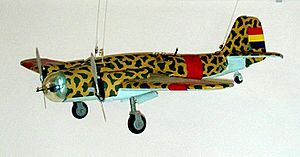
The Soviet Union helped the Spanish Republic when other countries would not. They sent weapons and pilots. Many of the best pilots in Spain were young men from the Soviet Union. The Spanish Republican Air Force needed modern planes and experienced pilots. Unlike most foreign pilots, Russian pilots were volunteers. They did not get extra pay for combat.
Many Soviet airmen arrived in late 1936 with new planes. The Soviet Union and Mexico were almost the only nations that helped Republican Spain. Joseph Stalin wanted Soviet pilots to gain combat experience. This was important for his plans for the Soviet Air Forces. So, they carefully reported on how new Russian equipment and air tactics worked.
The first planes from Russia were Tupolev SB bombers. Fighters came later. Their first mission was a bombing raid on the Talavera de la Reina airfield. This airfield was used by Nazi and Italian planes that bombed Madrid daily. This made the Russian pilots very popular in Madrid. The Katiuska pilots used their planes' speed to their advantage. But the planes were fragile, and their fuel tanks easily caught fire. When the Condor Legion brought faster Messerschmitt Bf 109 fighters, the SB squadrons suffered heavy losses.
Anatol Serov, known as "Mateo Rodrigo," started the Escuadrilla de Vuelo Nocturno (Night Flight Squadron). He did this with Mikhail Yakushin. This squadron used I-15 Chatos with changed exhaust pipes. This stopped flames from blocking the pilot's night vision. M. Yakushin became the leader of this Night Fighter Squadron. It was very effective against the Condor Legion's Ju 52 night bombing raids.
By late November 1936, about 300 Russian pilots were near Madrid. The improved defense of the Republic boosted morale. Russian pilots performed best in the Battle of Guadalajara. They defeated the Italian Aviazione Legionaria and bombed Fascist militias.
By late 1938, Soviet pilots were gradually replaced. Spanish airmen took their places after training at flying schools. These schools were set up by the Soviet military in places like Albacete and Alicante.
About 772 Russian airmen served the Spanish Republican Air Force. Of these, 99 died. Many who survived were later victims of the Stalin Purges when they returned to the USSR.
Pilot Training
Pilot training was handled by the Instruction Services (Servicios de Instrucción). All training units were under the Ministerio de Marina y Aire. During the Civil War, training bases were located across the Republican zone:
- The High-speed Flying School (Escuela de Vuelo de Alta Velocidad) was at the El Carmolí air base.
- The Bomber School (Escuela de bombardeo) was at the Santiago de la Ribera and Los Alcázares air bases.
- The Multiple-engined Aircraft School (Escuela de polimotores) was also at Santiago de la Ribera and Los Alcázares.
- The Aircraft Mechanics School (Escuela de mecánicos) was in Godella, Valencia Province.
- The Weaponry School (Escuela de Armeros) was in Eibar, Basque Country.
Fighter Aces
| Name | Country | Service | Victories | Observations |
|---|---|---|---|---|
| Lev L. Shestakov | Russia | 4ª Escuadrilla de Moscas | 39 | His total victory count may be 42 |
| Sergei I. Gritsevets | Russia | 5ª Escuadrilla de Caza | 30 | Nicknamed "Sergio" |
| Manuel Zarauza Clavero | Spain | 3ª & 4ª Escuadrilla de Caza | 23 | Reputed to be the most skilled Spanish pilot on the Mosca. Exiled in the USSR and KIFA over Baku on 12/October/1942 |
| Leopoldo Morquillas Rubio | Spain | 3ª & 2ª Escuadrilla de Caza | 21 | Also in Escuadrilla Vasca |
| Pavel Rychagov | Russia | 1ª Escuadrilla de Chatos | 20 | Nicknamed "Pablo Palancar". Arrested and executed in Stalin's 1941 purge |
| Anatol Serov | Russia | 1ª Escuadrilla de Chatos | 16 | Nicknamed "Mateo Rodrigo" He established the Escuadrilla Vuelo Nocturno night-flight squadron |
| Vladimir Bobrov | Russia | 13 | Flew more than 100 combat missions | |
| Andrés García La Calle | Spain | 1ª Escuadrilla de Chatos | 11 | Supreme commander of the fighter squadrons of the Spanish Republic in Dec. 1938 |
| Manuel Aguirre López | Spain | 1ª Escuadrilla, Grupo 21 | 11 | Also in 3ª Escuadrilla de Moscas |
| Abel Guidez | France | Escuadrilla España | 10 | |
| José María Bravo Fernández | Spain | 1ª & 3ª Escuadrilla de Caza | 10 | Became Commander of 3ª Escuadrilla de Caza and Grupo 21. Exiled in the USSR he took part in World War II as a Soviet pilot. Some documents ascribe him 23 victories |
| Juan Comas Borrás | Spain | 3ª Escuadrilla de Caza | 10 | Also in Escuadrilla Lacalle & Esc. Vasca. KIA on 24/Jan/1939 |
| Emilio Ramirez Bravo | Spain | 4ª Escuadrilla de Caza | 10 | Also in Escuadrilla Lacalle |
| Miguel Zambudio Martinez | Spain | Escuadrilla Vasca | 10 | Also in 3ª Escuadrilla de Caza, 26 Grupo de Caza |
| Antonio Arias Arias | Spain | 1ª, 3ª & 4ª Escuadrilla de Caza | 9 | Exiled in Russia, Arias fought in the Soviet Air Forces during World War II. He returned to Madrid as an old man in 1990 and retired. |
| Vicente Beltrán Rodrigo | Spain | 1ª Escuadrilla de Chatos | 9 | Also in 3ª Escuadrilla, Grupo 21, shot down in Battle of the Ebro. Exiled in Russia, joined the Soviet Air Forces. Returned to Spain in 1958 |
| Frank Glasgow Tinker | United States | 1ª Escuadrilla de Chatos | 8 | Part of the Yankee Squadron |
| Sabino Cortizo Bertolo | Spain | 5ª & 3ª Escuadrilla de Caza | 8 | KIA on 21/Jan/1939 |
| José Falcón San Martín | Spain | 5ª & 3ª Escuadrilla de Caza | 8 | Also in Escuadrilla Vuelo Nocturno |
| Pavel Agafonov | Spain | Escuadrilla Palancar | 8 | Nicknamed "Ahmed Amba". Returned to the USSR in April 1937 |
| Felipe del Río Crespo | Spain | Escuadrilla Vasca | 7 | Also in Escuadrilla Norte (1937); KIA on 23/Apr/1937 |
| Juan Lario Sanchez | Spain | 4ª & 2ª Escuadrilla de Caza | 7 | |
| Jan Ferák | Czechoslovakia | Escuadrilla España | 7 | Dewoitine D.372 pilot |
| Francisco Meroño Pellicer | Spain | 1ª & 6ª Escuadrilla de Caza | 7 | Also in Escuadrilla Norte (1937) |
| Orrin B. Bell | USA | 1ª Escuadrilla de Chatos | 7 | Shot down 7 He 51 over the Córdoba-Granada front |
| Andrés Fierro Menú | Spain | 1ª Escuadrilla de Chatos | 7 | Had engine trouble during a mission protecting Tupolev SB bombers; was taken prisoner following emergency landing at Almenar airfield. After escaping he reached the USSR where he joined the Soviet Air Forces |
| Francisco Tarazona Torán | Mexico | 1ª & 3ª Escuadrilla de Caza | 6 | Claims 8 victories in his autobiographical book. |
| José Pascual Santamaria | Spain | 1ª Escuadrilla de Caza | 6 | Also in Escuadrilla Norte (1937) |
| Ivan Trofimovich Yeryomenko | Russia | 1ª Escuadrilla de Chatos | 6 | Nicknamed "Ramón", "Antonio Aragón". or "Alexandrio" Leader of the 1ª Escuadrilla between May and October 1937. |
| Evgeny Nikolayevitch Stepanov | Russia | 1ª Escuadrilla de Chatos | 6 | Knew how to use the "aerial ramming" technique. Shot down over Ojos Negros and made prisoner on 17/Jan/1938 Returned to Russia and fought in World War II in the Soviet Air Forces |
| Božidar "Boško" Petrović | Yugoslavia | 2ª Escuadrilla, Grupo 12 | 5 | Nicknamed "Fernandez Garcia" |
| Rafael Magrina Vidal | Spain | 2ª Escuadrilla de Caza | 5 | KIA on 16/Jul/1937 |
| Julio Pereiro Peréz | Spain | 2ª, 4ª & 5ª Escuadrilla de Caza | 5 | |
| Harold E. Dahl | USA | Escuadrilla Lacalle | 5 | Nicknamed "Rubio". Also in 1ª Escuadrilla de Caza |
| Sergei Fyodorovich Tarkhov | Russia | 1ª Escuadrilla de Caza | 5 | Nicknamed "Capitán Antonio". Some authors claim Tarkhov flew a Chato. However, he was most likely a Mosca pilot. |
| William Labussière | France | 1ª Escuadrilla de Chatos | 5 | Fought also in World War II |
| James Peck | USA | 1ª Escuadrilla de Chatos | 5 | One of the few African-American pilots in the Spanish Republican Air Force. 4 victories unconfirmed |
Ranks
| Rank group | General/flag officers | Senior officers | Junior officers | Officer cadet | ||||||||||||||||||||||||||||||||
|---|---|---|---|---|---|---|---|---|---|---|---|---|---|---|---|---|---|---|---|---|---|---|---|---|---|---|---|---|---|---|---|---|---|---|---|---|
(1936–1939) |
 |
 |
 |
 |
 |
 |
||||||||||||||||||||||||||||||
| General | Coronel | Teniente coronel | Comandante | Capitán | Teniente | Alférez | ||||||||||||||||||||||||||||||
- Preceding agencies
| Rank group | General/flag officers | Senior officers | Junior officers | Officer cadet | ||||||||||||||||||||||||||||||||
|---|---|---|---|---|---|---|---|---|---|---|---|---|---|---|---|---|---|---|---|---|---|---|---|---|---|---|---|---|---|---|---|---|---|---|---|---|
(1931–1936) |
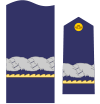 |
 |
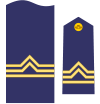 |
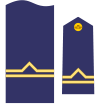 |
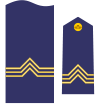 |
 |
 |
|||||||||||||||||||||||||||||
| Jefe Superior | Jefe de Base | Jefe de Escuadra | Jefe de Grupo | Jefe de Escuadrilla | Oficial Aviador | -
|
||||||||||||||||||||||||||||||
(1931–1936) |
 |
 |
 |
 |
 |
 |
||||||||||||||||||||||||||||||
| Capitán de navío | Capitán de fragata | Capitán de corbeta | Teniente de navío | Alférez de navío | Alférez de fragata | |||||||||||||||||||||||||||||||
Images for kids
-
Spanish Republican Air Force 2a Escuadrilla, Grupo 24 standard and pilot's summer uniform. La Sénia Museum
-
Romano R.80.2 of the military training facility at El Carmolí.
-
Fin flash of the Aeronáutica Naval, the naval aviation of the Spanish Republican Navy which was merged with the Air Force in September 1936
See also
 In Spanish: Fuerzas Aéreas de la República Española para niños
In Spanish: Fuerzas Aéreas de la República Española para niños
- Spanish Air Force
- Spanish Civil War
- LAPE (Líneas Aéreas Postales Españolas), Spanish Republican Airline
- List of aircraft of the Spanish Republican Air Force
- List of Spanish Civil War air aces
- Deutschland incident (1937)
- Aviazione Legionaria
- Condor Legion
- German re-armament
- Some Still Live
- Yankee Squadron
- Timofey Khryukin













